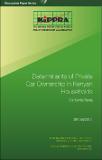Discussion Paper No. 144 of 2013 on Determinants of Private Car Ownership in Kenyan Households
View/
Publication Date
2013Author
Type
KIPPRA Publicationsviews
downloads
Metadata
Show full item record
Abstract/
In Kenya, policies in the transport sector largely support motorized transport at the expense of Non-Motorized and Intermediate Modes of Transport (NMIMT). These policies, together with the absence of vehicle retirement programmes among other factors, have contributed to increasing numbers of vehicles especially in cities, towns and urban areas. This increase is not equal in all categories; motor and auto cycles, saloon cars and station wagons are increasing faster than other categories such as buses, minibuses/matatus and coaches that are mainly used for public transportation. The rise in the number of saloon cars and station wagons is the main focus of this study as they are predominantly used for private transport in cities, towns and urban areas, and are largely privately owned. Their predominant use is a cause of concern as it has the potential of worsening the traffic problems being experienced now, thus reversing the gains that are intended to be achieved by the ongoing transport improvement projects. This will include increase in congestion, pollution and spending on infrastructure, energy scarcity and green house gas emissions. By employing Binary Logistic Regression analysis, the research analyzed the determinants of private car ownership at the household level, with a view of deducing policy recommendations aimed at managing private car populations in Kenyan cities, towns and urban areas. The study findings indicated that geographical area, gender, education, house tenure, employment status, type of dwelling and household income, influence private car ownership in Kenyan households...
Publisher
The Kenya Institute for Public Policy Research and Analysis (KIPPRA)Series
DP/144/2013;Collections
- Discussion Papers [342]

